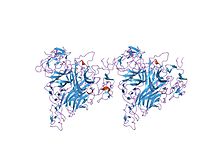Tumor necrosis factor superfamily
| TNF (Tumor Necrosis Factor) family | |||||||||
|---|---|---|---|---|---|---|---|---|---|

Trimeric structure of TNF alpha, produced by Mus musculus, based on PDB structure 2TNF (1.4 Å Resolution). Different colors represent different monomers. Baeyens, KJ et al. (1999). Figure rendered using FirstGlance Jmol.
|
|||||||||
| Identifiers | |||||||||
| Symbol | TNF | ||||||||
| Pfam | PF00229 | ||||||||
| InterPro | IPR006052 | ||||||||
| PROSITE | PDOC00224 | ||||||||
| SCOP | 1tnf | ||||||||
| SUPERFAMILY | 1tnf | ||||||||
| OPM superfamily | 357 | ||||||||
| OPM protein | 2hew | ||||||||
|
|||||||||
| Available protein structures: | |
|---|---|
| Pfam | structures |
| PDB | RCSB PDB; PDBe; PDBj |
| PDBsum | structure summary |
| TNF | |||||||||
|---|---|---|---|---|---|---|---|---|---|

crystal structure of trail-sdr5
|
|||||||||
| Identifiers | |||||||||
| Symbol | TNF | ||||||||
| Pfam | PF00229 | ||||||||
| Pfam clan | CL0100 | ||||||||
| InterPro | IPR006052 | ||||||||
| PROSITE | PDOC00561 | ||||||||
| SCOP | 1tnr | ||||||||
| SUPERFAMILY | 1tnr | ||||||||
|
|||||||||
| Available protein structures: | |
|---|---|
| Pfam | structures |
| PDB | RCSB PDB; PDBe; PDBj |
| PDBsum | structure summary |
The tumor necrosis factor (TNF) superfamily is a protein superfamily of type II transmembrane proteins containing TNF homology domain and forming trimers. Members of this superfamily can be released from the cell membrane by extracellular proteolytic cleavage and function as a cytokine. These proteins are expressed predominantly by immune cells and regulate diverse cell functions, including regulation of immune response and inflammation, but also proliferation, differentation, apoptosis and embryogenesis. The superfamily contains 19 members that bind to 29 members of TNF receptor superfamily. An occurrence of orthologs in invertebrates hints at ancient origin of this superfamily in evolution.
The PROSITE pattern of this superfamily is located in a beta sheet in the central section of the protein that is conserved across all members.
There are 19 family members, numerically classified as TNFSF#, where # denotes the member number, sometimes followed by a letter.
This article incorporates text from the public domain Pfam and InterPro IPR006052
...
Wikipedia
